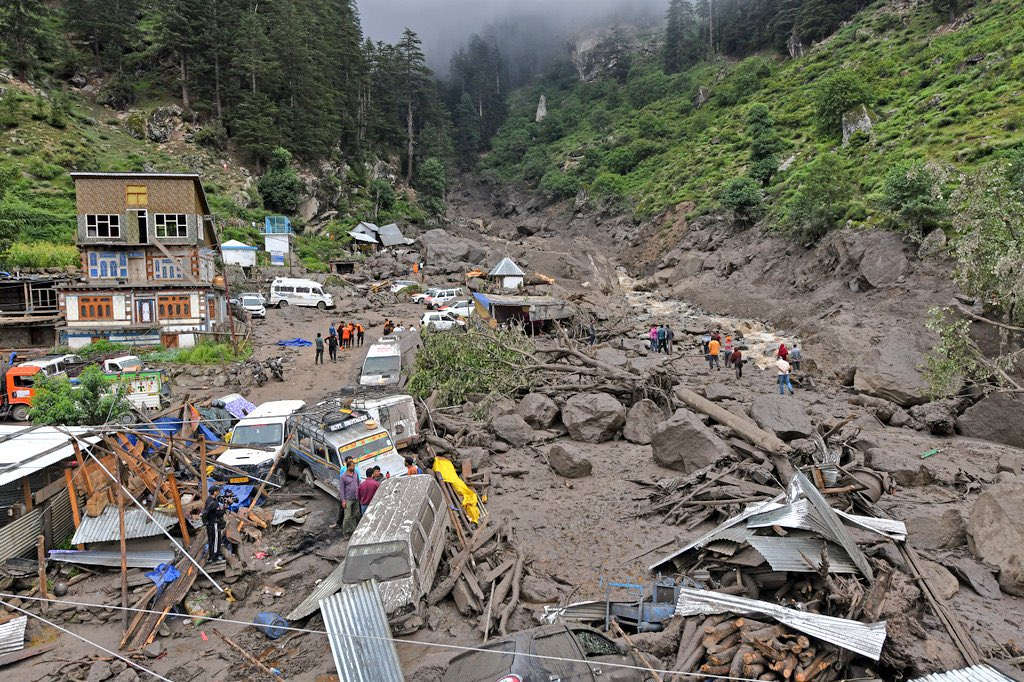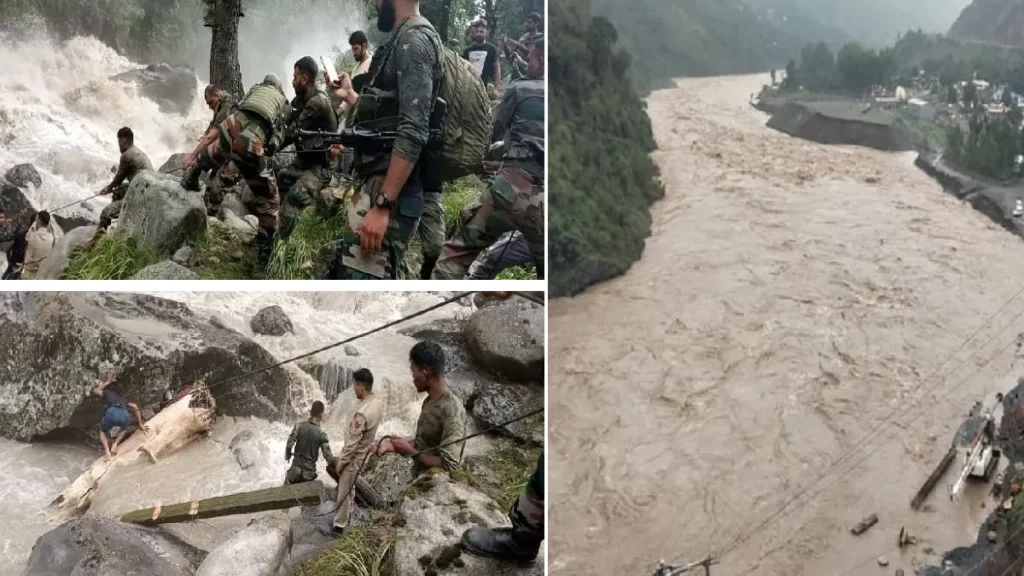By Ajaz Rashid
Jammu and Kashmir, cradled in the lap of the Himalayas, has always been a land of beauty and fragility. But in August 2025, nature’s fury struck twice in quick succession—a pair of devastating cloudbursts unleashed tragedy on Kishtwar and Kathua districts, leaving a trail of death, destruction, and haunting questions about the region’s future.
Disaster Strikes the Sacred Pilgrimage Route
On the morning of August 14, as dawn gave way to a bustling day at Chositi (Chashoti) village in Kishtwar district, few could have imagined that the heavens would soon turn menacing. The Machail Mata Yatra, a revered pilgrimage that draws thousands each year, was underway, with over 1,200 devotees, locals, and volunteers gathered in and around the last accessible village on the route.
Shortly after 11:30 a.m., a sudden, deafening cloudburst erupted above the narrow valley, sending torrents of rain and debris crashing down the mountain slopes. The tranquil stream that skirted Chositi swelled into a raging flood within moments. By the time the sky cleared, entire houses lay buried under mud; vehicles, bridges, and a bustling community kitchen for pilgrims had been swept away. Survivors recall scenes of horror: the earth shook, water levels rose with frightening speed, and people screamed as they were caught in the maelstrom. In the chaos, several pilgrims and villagers disappeared beneath the churning water and debris.

The death toll climbed quickly. By August 18, the numbers were staggering—at least 65 dead, over 300 injured, and nearly 200 still missing or feared trapped. The number of casualties included pilgrims and locals alike, underscoring the randomness of nature’s wrath. The flash floods also claimed lives downstream, where bodies were recovered far from the main disaster zone. Emergency responders—army engineers, police, and NDRF teams—worked round the clock, blasting through boulders and wading through knee-deep mud to rescue the trapped and recover the dead.

Infrastructure suffered massive damage. Makeshift markets, a temple kitchen (langar), 16 homes, government buildings, temples, water mills, a long footbridge, and a dozen vehicles were all swept away or left in ruins. The only bridge to Chositi collapsed, cutting off survivors from outside help for precious hours. Helicopters ferried supplies, and villagers joined forces with security personnel, their faces etched with fear and exhaustion, digging through the sludge with bare hands in the hope of finding loved ones alive.
Tragedy Follows Tragedy
As Kishtwar reeled from its catastrophe, another ominous weather system gathered above Kathua. On the night of August 16-17, heavy rain lashed the region. Between 3:30 and 4:00 a.m., a violent cloudburst struck the Jodh Ghati area. Landslides and flash floods followed, inundating homes, crushing lives, and sparking panic in the darkness.
By morning, at least seven people—including five children—were confirmed dead, their lives cut short as their houses and surroundings were swept away. The railway track, a critical national highway segment, and even the local police station suffered damage. Rescue teams—army, NDRF, SDRF, civil administration—rushed in, evacuating the injured (many of whom were airlifted to hospitals) and beginning the arduous work of clearing debris.
Train services between Jammu and Pathankot were disrupted as water roared beneath a crucial bridge, threatening to tear it from its foundations. Homes and roads vanished in the flood; entire villages faced isolation as landslides wiped out approaches. A stunned Deputy Commissioner Rajesh Sharma described the scope of devastation, citing the loss of life, ruined roads, and the mass displacement of local residents.
The national spotlight turned toward both Kishtwar and Kathua. Senior government leaders assured all possible support, while the local populace mourned the dead and grappled with the scale of damage to lives and livelihoods.
Science, Warnings, and the Shadow of Climate Change
While survivors and rescuers confronted the immediate aftermath, observers and scientists saw in this double tragedy the contours of a larger, spreading crisis. Cloudbursts—intense downpours over short periods—have become increasingly common in the Himalayas. Rising temperatures, say experts, allow the air to hold more moisture, raising the chances of extreme rainfall. The unique topography of Jammu and Kashmir—steep valleys, thin soils, and fragile geology—only amplifies the risks. When moist monsoon winds collide with cold western disturbances, the sky can release enormous volumes of water in an abrupt, fatal burst.
Worsening the threat are man-made factors. The rapid expansion of roads, unplanned construction, deforestation, and reckless tourism have left many mountain slopes unstable. As journalists and activists have highlighted, each year the region sees more multi-faceted disasters: cloudbursts transform quiet valleys into “deadly corridors” of water, stone, and mud. The tragedy at Kishtwar, coming just days after similar events in Ramban and Pulwama, is an ominous sign of things to come.

Calls have grown for institutional action. Organizations like the Wadia Institute of Himalayan Geology, and even the Indian Meteorological Department, have pressed for improved forecasting systems, satellite-based monitoring, and strict enforcement of zoning rules. Many cloudbursts—especially in deep valleys—escape radar detection until it’s too late. The question lingers: will this be the wakeup call that finally brings systemic change?
Human Stories
Amidst the data, numbers, and warnings, the personal stories remain the most poignant. In Chositi, families search desperately through debris for missing relatives. Survivors, their belongings scattered beneath mounds of sand and stone, recite the names of neighbors and friends still unaccounted for. At impromptu relief camps, volunteers cook hot meals, share blankets, and comfort the grieving.
In Kathua, children who once played cricket in open fields now huddle with their families in tents. “We never thought the river could rise so high,” weeps a mother, staring at the gulley where her house once stood. The army, often seen as distant or formal, is now a presence of hope; jawans carry injured elders to helicopters and ferry children across makeshift bridges.
As the monsoon clouds drift east, prayers are offered in mosques and temples. The heavens, which brought the tragedy, are now beseeched for mercy—and change.
A Region at a Crossroads
The dual disasters of August 2025 in Kishtwar and Kathua are not just tales of heartbreak. They are warnings, stark and urgent, about what awaits Jammu and Kashmir if present trends continue. The people of these mountains—survivors and mourners alike—are wrestling with fundamental questions. Can their homes, traditions, and livelihoods withstand the growing violence of the weather? Will action follow the annual cycle of promises and platitudes?
The answers may lie in a new humility before nature, coupled with the courage to act: to rebuild smarter, manage resources wisely, and respect the warnings from both the earth and the sky. The Himalayas, ancient and formidable, have endured centuries of storms. But for their people, these cloudbursts mark a painful new chapter—one that they must navigate, together and with resolve, into an uncertain future.